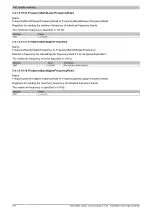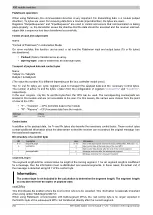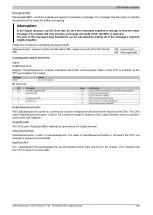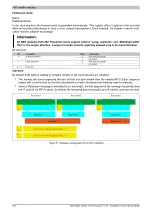
X90 mobile modules
210
X90 mobile system User's manual V 1.20 - Translation of the original manual
First, the messages must be split into segments. In the default configuration, it is important to ensure that each
sequence can hold an entire segment, including the associated control byte. The sequence is limited to the size of
the enable MTU. In other words, a segment must be at least 1 byte smaller than the MTU.
MTU = 7 bytes → Max. segment length = 6 bytes
•
Message 1 (7 bytes)
➯
First segment = Control byte + 6 bytes of data
➯
Second segment = Control byte + 1 data byte
•
Message 2 (2 bytes)
➯
First segment = Control byte + 2 bytes of data
•
Message 3 (9 bytes)
➯
First segment = Control byte + 6 bytes of data
➯
Second segment = Control byte + 3 data bytes
•
No more messages
➯
C0 control byte
A unique control byte must be generated for each segment. In addition, the C0 control byte is generated to keep
communication on standby.
C0 (control byte 0)
C1 (control byte 1)
C2 (control byte 2)
- SegmentLength (0)
=
0 - SegmentLength (6)
=
6 - SegmentLength (1)
=
1
- nextCBPos (0)
=
0 - nextCBPos (0)
=
0 - nextCBPos (0)
=
0
- MessageEndBit (0)
=
0 - MessageEndBit (0)
=
0 - MessageEndBit (1)
=
128
Control byte
Σ
0 Control byte
Σ
6 Control byte
Σ
129
Table 21: Flatstream determination of the control bytes for the default configuration example (part 1)
C3 (control byte 3)
C4 (control byte 4)
C5 (control byte 5)
- SegmentLength (2)
=
2 - SegmentLength (6)
=
6 - SegmentLength (3)
=
3
- nextCBPos (0)
=
0 - nextCBPos (0)
=
0 - nextCBPos (0)
=
0
- MessageEndBit (1)
=
128 - MessageEndBit (0)
=
0 - MessageEndBit (1)
=
128
Control byte
Σ
130 Control byte
Σ
6 Control byte
Σ
131
Table 22: Flatstream determination of the control bytes for the default configuration example (part 2)
















































